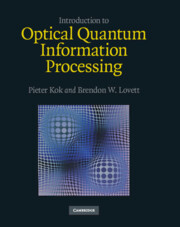Book contents
- Frontmatter
- Dedication
- Contents
- Preface
- Part I Quantum optics and quantum information
- Part II Quantum information in photons and atoms
- Part III Quantum information in many-body systems
- 8 Quantum communication with continuous variables
- 9 Quantum computation with continuous variables
- 10 Atomic ensembles in quantum information processing
- 11 Solid-state quantum information carriers
- 12 Decoherence of solid-state qubits
- 13 Quantum metrology
- Appendix A Baker–Campbell–Haussdorff relations
- Appendix B The Knill–Laflamme–Milburn protocol
- Appendix C Cross–Kerr nonlinearities for single photons
- References
- Index
9 - Quantum computation with continuous variables
from Part III - Quantum information in many-body systems
Published online by Cambridge University Press: 05 July 2014
- Frontmatter
- Dedication
- Contents
- Preface
- Part I Quantum optics and quantum information
- Part II Quantum information in photons and atoms
- Part III Quantum information in many-body systems
- 8 Quantum communication with continuous variables
- 9 Quantum computation with continuous variables
- 10 Atomic ensembles in quantum information processing
- 11 Solid-state quantum information carriers
- 12 Decoherence of solid-state qubits
- 13 Quantum metrology
- Appendix A Baker–Campbell–Haussdorff relations
- Appendix B The Knill–Laflamme–Milburn protocol
- Appendix C Cross–Kerr nonlinearities for single photons
- References
- Index
Summary
In the previous chapter we have discussed some important quantum information processing techniques based on continuous variables, or ‘qunats’. In this chapter, we describe methods for extending these techniques to quantum computation with optical qunats. We will first show in Section 9.1 how the optical qunat states are initialized using single-mode squeezing, and we give optical implementations of some of the most important single-qunat gates, such as the Heisenberg-Weyl operators and the Fourier transform. In Section 9.2, we study the theory of two-mode Gaussian operations, and we construct a general optical circuit that can implement any two-mode Gaussian operation. In Section 9.3, we introduce the stabilizer formalism for qunats, and use it to derive a Gottesman-Knill theorem. This leads to the general requirement of nonlinear gates for qunats, and their optical implementation will be discussed in Section 9.4. Having thus established the optical implementation of universal quantum computing with continuous variables, we extend this to the one-way model in Section 9.5, where we introduce cluster states for continuous variables. Finally, in Section 9.6, we discuss various quantum error-correction techniques for qunat quantum computing.
Single-mode optical qunat gates
We have already seen in Chapter 2 that the single qunat gates are fundamentally different from qubit gates. In the context of optical implementations, this difference arises due to the complementary nature of qubits and qunats: qubits that are represented by single photons can be considered particles, whereas qunats are encoded in the wave properties of the optical field.
- Type
- Chapter
- Information
- Introduction to Optical Quantum Information Processing , pp. 294 - 326Publisher: Cambridge University PressPrint publication year: 2010



